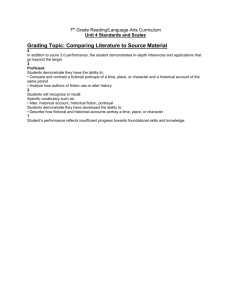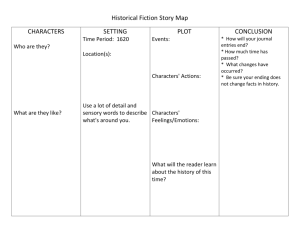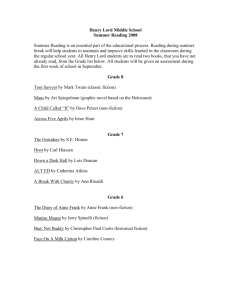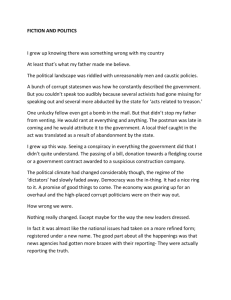Why Scientific Models are not Works of Fiction - PhilSci
advertisement
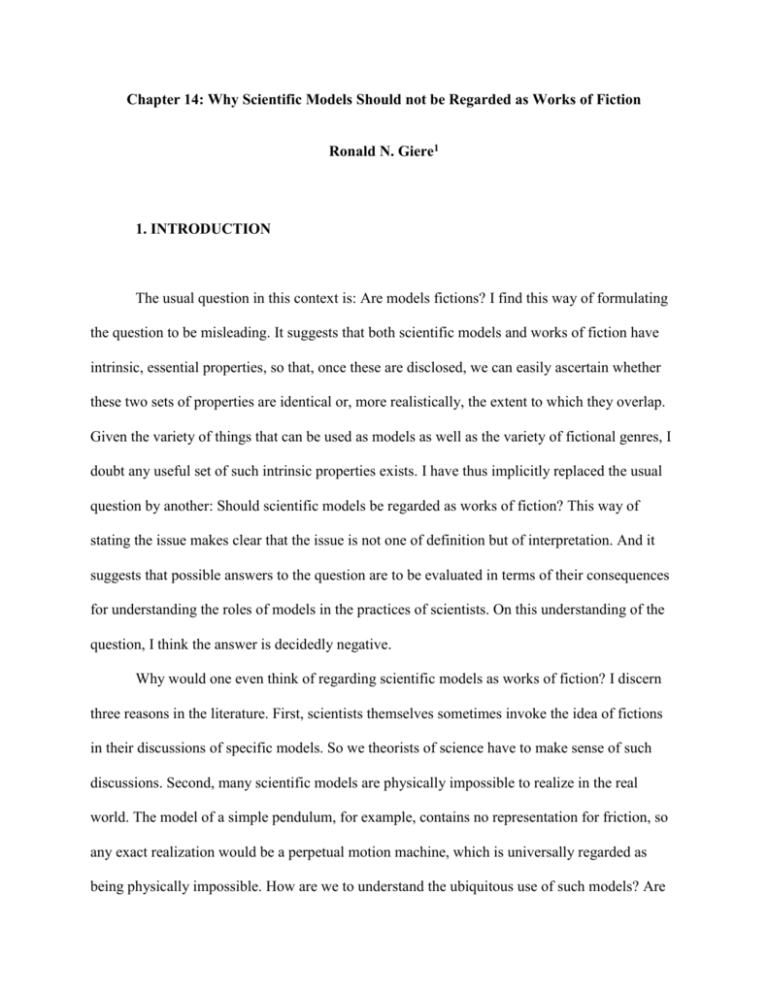
Chapter 14: Why Scientific Models Should not be Regarded as Works of Fiction Ronald N. Giere1 1. INTRODUCTION The usual question in this context is: Are models fictions? I find this way of formulating the question to be misleading. It suggests that both scientific models and works of fiction have intrinsic, essential properties, so that, once these are disclosed, we can easily ascertain whether these two sets of properties are identical or, more realistically, the extent to which they overlap. Given the variety of things that can be used as models as well as the variety of fictional genres, I doubt any useful set of such intrinsic properties exists. I have thus implicitly replaced the usual question by another: Should scientific models be regarded as works of fiction? This way of stating the issue makes clear that the issue is not one of definition but of interpretation. And it suggests that possible answers to the question are to be evaluated in terms of their consequences for understanding the roles of models in the practices of scientists. On this understanding of the question, I think the answer is decidedly negative. Why would one even think of regarding scientific models as works of fiction? I discern three reasons in the literature. First, scientists themselves sometimes invoke the idea of fictions in their discussions of specific models. So we theorists of science have to make sense of such discussions. Second, many scientific models are physically impossible to realize in the real world. The model of a simple pendulum, for example, contains no representation for friction, so any exact realization would be a perpetual motion machine, which is universally regarded as being physically impossible. How are we to understand the ubiquitous use of such models? Are Giere. p. 2. they themselves, or do they represent, fictional entities? Third, regarding scientific models as fictional may be part of a general fictionalist understanding of scientific theories. On this view, theoretical models contain or represent fictional entities. Only representations of things that may be experienced in practice can be veridical. In the end I will reject each of these reasons for regarding scientific models as works of fiction. But first I want sharply to distinguish between the ontology of scientific models and their function in the practice of science.2 Theoretical models and works of fiction are, I will argue, ontologically on a par. It is their differing functions in practice that makes it inappropriate to regard scientific models as works of fiction. 2. ARE FICTIONS MODELS? THE ONTOLOGY OF FICTIONS AND MODELS Scientific models seem to be ontologically quite diverse, including physical scale models, diagrams and abstract (or theoretical) structures. There are several ways of dealing with this diversity. One way is to take physical models, diagrams, etc., as being ontologically unproblematic and concentrate on the more problematic abstract models. A second, more radical, solution is to regard physical models, diagrams, etc., as resources for partially characterizing abstract models. So, all scientific models are regarded as being abstract, or at least having abstract counterparts. For the present inquiry it does not matter which of these alternatives one chooses since it seems to be only abstract models for which there is any question about their possible status as works of fiction. One way of approaching questions about the ontology of models and fictions is to ask the reverse of the standard question about relationships among models and fictions. Are fictions Giere. p. 3. models? I would, of course, rephrase this as the question of whether in creating a work of fiction one should be regarded as also creating models. Here I think the answer is decidedly positive. Consider a quintessential work of fiction, such as the novel War and Peace. I claim that Tolstoy can be regarded as having created an elaborate possible world, which is to say, a model (perhaps consisting of many less elaborate models) of a possible world.3 This model in fact resembles the real world in many respects. It speaks of such actual things as Napoleon’s invasion of Russia, life and death, love and loss. It was, indeed, intended to represent such things. To the best of my knowledge, this is a model that could have been realized in the real world. It is what Peter Godfrey-Smith (2006) has called an “imagined concrete thing.” In fact, it has been realized several times in films. That the original work describes a model is shown by the fact the film realizations necessarily add details, such as some features of the main characters. But the films, too, like the novel, are just models of a possible world characterized in terms of spoken words and pictures. Of course, not all works of fiction describe things that could be realized in the actual world. Mark Twain’s A Connecticut Yankee in King Arthur's Court, which invokes traveling backward in time, is a well-known example of such a work. It is widely assumed that a work of fiction is a creation of human imagination. I think the same is true of scientific models. So, ontologically, scientific models and works of fiction are on a par. They are both imaginary constructs. It is also relatively uncontroversial that the ability to create imaginary objects is facilitated by language. This is very clear in the fundamental case of planning and decision making. In response to a given situation, one may imagine and describe possible courses of action and likely outcomes of these possible actions. In an ideal case, only one of these possible actions is carried out, leaving the rest as merely imagined possibilities. Of Giere. p. 4. course, imagined scenarios vastly underdetermine, and indeed, are typically contradicted by, the actual course of events.4 The connection between producing scientific models and producing works of fiction must be deeper still. Surely the imaginative processes at work in producing a scientific model are similar to those invoked in producing a work of fiction. There are many ways one might study these processes. For example, one might have expected that the contemporary cognitive sciences could shed some light on these processes. That seems not to be the case.5 There does, however, seem to be a large literature on the general nature of fiction and fictional entities among literary theorists and some philosophers.6 One can also study authors who produce works of fiction as well as scientists who have constructed significant scientific models. Many works of biography by historians and historians of science are explicitly concerned with what is commonly called “the creative process.”7 The question, for me, however, is whether we, as philosophers of science interested in understanding the workings of modern science, need a deeper understanding of imaginative processes and of the objects produced by these processes. To take a case close to home, when I call theoretical models “abstract,” I mean mainly that they are “not concrete,” which is the core meaning given in dictionaries. Objects in the world, including scale models, are “concrete.” One can, of course, inquire further into what it might mean to call theoretical models “abstract.” Are they, for example, similar to mathematical models? Does the fact that abstract models do not exist in actual space and time imply that we cannot talk about the period of a simple pendulum? Do the terms “length” or “period” mean the same thing when applied to the model of a simple pendulum as when applied to a concrete pendulum?8 If, ontologically, models are imaginary objects in the way objects of fiction are imaginary objects, the answers to these questions are negative. We surely would not want to say Giere. p. 5. a character in War and Peace is a mathematical object, nor that such a character could not be described as traveling from one place to another, nor that the word “war” means something different in the novel than in real life. More positively, my view is similar to Cartwright’s (1999). Some things she calls “laws” I call “theoretical principles” which characterize (and are true of) highly abstract models which, however, cannot be used to represent anything in particular. For that one needs more specific models which embody the principles. But even a fully specified model that is intended to represent a particular concrete system is still an abstract object. I remain to be convinced that we need say much more than this to get on with the job of investigating the functions of models in science.9 3. FICTION, NON-FICTION, AND SCIENCE FICTION: THE FUNCTIONS OF SCIENTIFIC MODELS AND WORKS OF FICTION In spite of sharing an ontology as imagined objects, scientific models and works of fiction function in different cultural worlds. One indication of this difference is that, while works of fiction are typically a product of a single author’s imagination, scientific models are typically the product of a collective effort. Scientists share preliminary descriptions of their models with colleagues near and far, and this sharing often leads to smaller or larger changes in the descriptions. The descriptions, then, are from the beginning intended to be public objects. Of course, authors of fiction may share their manuscripts with family and colleagues, but this is not part of the ethos of producing fiction. An author would not be professionally criticized for Giere. p. 6. delivering an otherwise unread manuscript an editor. Scientists who keep everything to themselves before submitting a manuscript for publication are regarded as peculiar and may be criticized for being excessively secretive. Turning to a more public arena, the Table of Contents of the weekly book review section of the New York Times has two main categories: Fiction and Non-Fiction. Although reviewers often point out mistakes in works of non-fiction, that is not taken as a ground for moving these works into the fiction category. It does, however, sometimes happen that a work marketed as non-fiction turns out to describe events many or even most of which are later discovered never to have happened. Trying to pass off a work of fiction as non-fiction may destroy an author’s career. There have even been cases in which an author’s career was derailed for trying to pass off fictional composites of real people as a single real person. Thus, while the boundary between fiction and non-fiction is not sharp, it is well understood. This applies to science as well. Works popularizing new scientific theories are listed as Non-Fiction. Works of science fiction are, of course, listed as Fiction. Even books describing eleven dimensional vibrating membranes or multiple universes, which sound to many ears as being “stranger than fiction,” are classified as Non-Fiction so long as they are written by recognized scientific authorities and intended as at least possible scientific descriptions of the world. In fact, regarding claims about the fit of scientific models to the world as fictional destroys the well regarded distinction between science and science fiction. Thus, imagining light traveling in totally empty space, which we now think does not exist anywhere, can be part of good science. Imagining the spaceship Enterprise traveling at “warp speed” (faster than light) is Giere. p. 7. science fiction. The general view that to create a scientific model is to create a work of fiction obliterates this well-founded distinction. There also seems to be no one primary function for works of fiction. At their most exalted, such as War and Peace, they provide insights into “the human condition,” albeit in a culturally specific time and place. But there are whole genres of fiction, such as Romance/Fantasy, whose main function seems to be simply to entertain. Then, of course, there is pornography. Scientific models also serve many purposes.10 One purpose, however, stands out from the rest. Scientific models typically function as a means for representing aspects of the world. Representational virtues are many, such as scope, accuracy, precision and detail. These virtues may sometimes conflict; for example, one must often trade off scope against detail. Still, a failure appropriately to represent its target is a grounds for criticism, even rejection, of a scientific model. Remember the many models that were proposed and rejected in the race for the double helix because they failed adequately to represent the structure of DNA molecules. In the realm of fantasy, such criticisms are not appropriate. It is no criticism of the Harry Potter novels that there is no community of genuine wizards. Nor is it a criticism of War and Peace that its main characters did not exist. 4. SCIENTISTS’ FICTIONS One motivation for taking seriously a connection between scientific models and works of fiction is that scientists themselves sometimes explicitly invoke just such a connection. A brief Giere. p. 8. look at some examples of this phenomenon suggests, however, that there is no implication that scientific models themselves should be regarded as works of fiction. Paul Teller (Forthcoming) reminds us of the following textbook example of the method of image charges. Imagine an infinite metal plate with a positive point charge located a distance, d, from the plate. The problem for the student is to determine the induced charge distribution on the plate using known principles of electrostatics. Applying the method of image charges, one replaces the original model with a model in which the infinite metal plate is replaced by a “fictional” negative charge placed symmetrically on the other side of where the surface had been in the original model. The solution to the problem using the new model, in full accord with electrostatic theory, is exactly the same as if one had solved the mathematically more difficult problem using the initially suggested model. What is meant by calling the negative charge in the second model “fictional”? As a component of a model, the image charge in the second model is no more and no less fictional than the positive point charge and infinite metal surface in the original model. It is telling that textbooks do not refer to the latter as “fictional” although they are clearly physically impossible entities. My analysis of the situation is that the original model is understood to be an idealized representation of a concrete system. The concrete system would only have counterparts to the original positive charge and conducting surface. Relative to this suggested concrete system, the negative charge in the second model is called “fictional” because it would have no counterpart in the assumed concrete system. On this understanding of the situation, there is no basis for calling either model as a whole a work of fiction. Eric Winsberg (Forthcoming) describes an advanced contemporary case of a model with a “fictional” component. The problem is to model a growing fracture in a micron sized piece of Giere. p. 9. silicon. At the point of the fracture, the best models are based on quantum mechanical (QM) principles. A little further out, QM models become computationally intractable. So in this region one employs models using principles from classical molecular dynamics (MD). Further out, MD models become computationally intractable, so the outer region is modeled using principles from classical continuum mechanics (CM). There is a problem, however, in that there is no computationally tractable way of modeling the transition from the QM region to the MD region. This problem is solved by introducing into the model a fictional type of molecule, dubbed “silogens,” that have some properties of silicon and other properties of hydrogen. In the resulting model, silogens are placed on the boundary between the QM and MD regions, and make modeling the transition computationally tractable. The payoff is that the resulting model is both computationally tractable and can be used as a scientifically and technologically adequate representation of the whole concrete system. As in the case of the method of image charges, silogens are not called “fictional” because they are elements of an idealized model. That is true also of the elements of the models based on quantum mechanics, molecular dynamics, and continuum mechanics. Rather, while the latter models are taken to provide a useful fit to real features of the target system (micron sized pieces of silicon), silogens are not intended to model anything in a concrete system, it being known that there are no such things in the real world. Relative to the real world, they are fictions, but this role provides no grounds for regarding the overall model as a work of fiction. This model provides a scientifically adequate representation of real systems. Not all examples of models for which scientists themselves invoke the notion of fictions involve just a fictional element in a model that as a whole is representationally adequate. Some models are, as a whole, fictional. Maxwell’s mechanical model of the supposed ether is a much Giere. p. 10. discussed example of this sort (Nersessian 1992; Morrison, Forthcoming). There is probably no single function served by all such models. In the Maxwell case, the fictional mechanical model provided a crucial analogy for the construction of a field theory of electro-magnetism. So one can say that its function was heuristic rather than representational. But, as Morrison argues, this is a mere template for understanding its role in Maxwell’s thought. What matters is how the analogy functions, and this will vary from case to case. In Maxwell’s case, a more informative description of the role of the mechanical analogy is that it provided analogs of relationships among variables in the final electromagnetic theory, but this description still needs to be filled out in more detail. The important point here is that there are no grounds for regarding Maxwell’s mechanical model as functioning like a work of fiction. Finally, the fact that scientists themselves sometimes use the word “fictional” to describe an element of a model, or even a whole model, provides little ground for concluding that these models function as works of fiction in anything like the way novels function as works of fiction. My guess is that when scientists describe part of a model as fictional they mean little more than that it has no counterpart in reality. The term “fictional” in these contexts is a term of convenience that has few meta-theoretical implications. It is doubtful that many scientists ever consider the possibility that fictional models might function like literary works of fiction. It is more doubtful that they distinguish between the ontology and the functions of models. In general, scientists are not experts in the meta-theory of their practice. In fact, scientists' metatheories often derive uncritically from diverse sources such as professional folklore and popularized philosophy of science. They typically have no worked out conceptual scheme in which even to state their meta-theory. Their science does not require such. So knowledgeable outsiders such as historians and philosophers of science may have a better meta-conception of Giere. p. 11. what they are doing than they themselves. One task for historians, philosophers and sociologists of science is to provide scientists with a better meta-understanding of their own practice. 5. THE ARGUMENT FROM IMPERFECT FIT A second apparent motivation for associating scientific models with works of fiction is the undisputed fact that most abstract models, particularly those characterized mathematically, cannot possibly exhibit a perfect fit to any real system. According to our most fundamental theories, it is physically impossible for the world to include mass points, frictionless motions, perfect vacuums, perfectly flat space-time regions, infinite populations, etc. But this consideration hardly shows that claims about the good fit of models to the world function as fictitious claims. Models incorporating such objects figure prominently in good scientific practice and often provide a very good fit to their intended targets in the real world. It violates scientific practice to regard claims of good fit for these models as functionally fictional claims. Idealizations, abstractions, and approximations, yes.11 Fictions, no. In fact, the argument from imperfect fit to a functionally fictional status for models proves far too much. It is a commonplace of cognitive science that all thought and communication involves idealized categories, stereotypes being a prominent example of this phenomenon. Similarly, for several decades, cognitive scientists have argued that ordinary empirical categories are not strictly binary, but graded from central to peripheral cases (Smith & Medin 1981). So if idealization and the resulting lack of perfect fit imply that models should be regarded as fictions, most of what everyone thinks and says is should be regarded as fictional. Giere. p. 12. Once again, the functional distinction between works of non-fiction and works of fiction is obliterated. It seems to me that the assimilation of scientific models to works of fiction presupposes an exaggerated conception of non-fiction. On this conception, a genuine work of non-fiction has to provide “the truth, the whole truth, and nothing but the truth.” Thus, the realization that scientists are mostly in the business of constructing models that never provide a perfect fit to the world leads to the unwarranted conclusion that scientists are in the business of producing fictional accounts of the world. It also seems to me that part of what drives the move to fictions is the assumption that scientists must mostly be talking about real systems, so when they ascribe features that we know do not exist to a real system, we are forced to look for some other conception of what they are doing. That they are creating fictional properties is one possible conception. But the problem is much less acute if, instead, we conceive scientists as talking much of the time not about a real system but about an abstract model of a real system.12 The model can have properties we know the real system does not. Then the question is, as always for models, how similar the model is to the real system of interest which lacks counterparts for some elements of the model. In addition, utilizing similarity as the relation between models and the world helps to solve the problem raised by models not exactly matching the world due to abstraction, approximation and idealization. 6. NEO-FICTIONALISM Giere. p. 13. A third and even deeper philosophical motivation behind the movement to regard scientific models as works of fiction is its apparent support for what I am here calling “neofictionalism.” It might also be called “neo-instrumentalism,” or, if a more positive sounding label is desired, “pragmatism.” One gets more than hints of this motivation in the locus classicus for current discussions of fictionalism, Arthur Fine’s 1993 paper, “Fictionalism.” This paper is a sympathetic commentary on one of the most extensive works on fictionalism ever written, Hans Vaihinger’s The Philosophy of ‘As If’ (1924). As Fine points out, Vaihinger, who saw fictions everywhere, nevertheless contrasted “fictions” (actually “semi-fictions”) with what he called scientific “hypotheses” which he thought could be straightforwardly true or false. Thus, although Vaihinger rightly did not attempt to provide a sharp demarcation between “fictions” and “hypotheses,” he nevertheless maintained a robust sense of the difference between fiction and non-fiction, at least for science. Fine is in clear agreement with Vaihinger on the point that “Vaihinger regards the inference from utility to reality as fundamentally incorrect.” (p. 8) Or, as restated a few lines later, he claims that Vaihinger was very concerned to demonstrate “that the inference from scientific success at the instrumental level to the literal truth of the governing principles is thoroughly fallacious.” These are claims that Fine himself has often made in his own behalf (Fine 1986). They are part of his critique of realist interpretations of theoretical scientific claims. So Fine’s fictionalism, in the persona of Vaihinger, is being employed in the service of antirealism (or at least non-realism). This judgment accords with the fact that Fine’s paper begins and ends with references to contemporary disputes between realists and anti-realists. It accords also with his discussion of the last recent philosopher of science seriously to discuss fictionalism, Israel Scheffler (1963).13 Giere. p. 14. Since this is clearly not the place to argue these deeper issues at any length, I will make only one major point. The claim “that the inference from scientific success at the instrumental level to the literal truth of the governing principles is thoroughly fallacious” is itself fallacious. It is so because both the supposed premise and conclusion of the inference are misconceived. First, how are we to understand the premise, “scientific success at the instrumental level”? One way is suggested in Fine’s characterization of Vaihinger as holding that “fictions are justifiable to the extent to which they prove themselves useful in life’s activities” (p. 7). This sounds like something that might have been written by John Dewey. And, indeed, inferences from practical success to “literal truth” are questionable. But moderate scientific realists like myself would emphasize success in experiments deliberately designed and executed in order rigorously to test specific hypotheses claiming a good fit between a model and some concrete system. So the premise is not just success in experience, but experimental success. Second, the conclusion for a moderate realist is not “the literal truth of general principles” but merely the appropriate fit of specific models to some aspects of the world. In my framework, realist conclusions go only as high as the fit of specific models to designated aspects of the world. There is no inference to the literal truth of more general principles which serve mainly to define the most abstract models. These principles are true only of the models they define.14 With these changes in both premises and conclusions, the inference in question is no longer obviously fallacious but arguably quite reasonable. Finally, the view that scientific models are ontologically like works of fiction in being imaginary creations not only does not uniquely support fictionalism, but is compatible with a moderate realism.15 There is nothing in this notion of a scientific model that prevents identifying Giere. p. 15. elements of models with things traditionally classified as “unobservable.” On the other hand, as discussed above, some elements of models may not be identified with anything in the world. 7. CULTURAL CONSIDERATIONS There are cultural dangers, particularly in the United States, in the general claim that scientific models are fictions. For religiously inspired anti-science movements, such as “creation science,” learning that respected philosophers of science think that science is just a matter of fictions would be welcome news indeed. Even worse, for those who embrace Walton’s (1990) account of fiction, scientific representation is a matter of “make believe.” We need only remember how creationists and other opponents of evolutionary theory welcomed Karl Popper’s claims that evolutionary theory is not falsifiable and thus not a scientific theory, but, rather, a metaphysical research program.16 Niceties aside, this view was taken as providing justification for the metaphysical claims of religion as being on a par with those of science. Those of us who agree with Vaihinger that religions claims about gods, prophets, and the like are fictional, should, in the present cultural climate, be reluctant to place the claims of modern science on the same footing.17 So the view that scientific claims are fictional is not one that supporters of a genuine scientific ethos should encourage. Indeed, in the present cultural climate, it would be irresponsible publicly to promulgate such views in these terms. At the very least, supporters of this view should come up with another description of their views. Perhaps “Instrumentalism” or “Pragmatism” would do. “Fictional” is far too loaded a word. Giere. p. 16. I must admit that even the view that, ontologically, scientific models, like works of fiction, are creations of human imagination raises some of the same problems, especially if, as is likely, the distinction between ontology and function is ignored. Nevertheless, this version of the cultural problem may be easier to counter than the blanket claim that scientific models are works of fiction. The idea, much beloved by scientists, that doing science involves creativity and imagination, has long been accepted by the general population as a positive, indeed, humanizing, feature of science. Moreover, the idea that scientific models, unlike religious claims, are subject to rigorous experimental testing provides a means of demarcating science from religion. This, of course, sounds a bit like Popper’s invocation of the now rejected distinction between “discovery” and “justification” in support of his views that doing science is a matter of conjectures and refutations, and that scientific claims must be falsifiable. One difference is that we now distinguish between claims that a particular model well fits its target, which can sometimes be clearly falsified, and larger units, paradigms, research programs, or perspectives, which are not subject to simple falsification but can, over time, be rejected. In addition, we no longer relegate the creative process to a mysterious “creativity” subject at most to psychological investigation. As shown by the work of Darden (1991), Nickles (1980), Nersessian, Morrison, and many others, the scientific imagination is guided by identifiable heuristic strategies and subject matter specific constraints. Thus, the view that scientific models are initially a product of scientific imagination is indeed far easier to defend against misuse than a blanket claim that they are works of fiction. REFERENCES Giere. p. 17. Barberousse, Anouk (Forthcoming), “Models as Fictions”, in Mauricio Suárez, (ed), Fictions in Science: Philosophical Essays on Modeling and Idealization. Oxford: Routledge. Bechtel, William, and George Graham (eds),(1998), A Companion to Cognitive Science. Oxford: Blackwell. Cartwright, Nancy. D. (1999), The Dappled World. Cambridge: Cambridge University Press. Contessa, Gabriel (Forthcoming), “Scientific Models as Fictional Objects”, Synthese. Darden, Lindley (1991), Theory Change in Science: Strategies from Mendelian Genetics. New York: Oxford University Press. Fine, Arthur (1986), “Unnatural Attitudes: Realist and Instrumentalist Attachments to Science”, Mind 95:149-179. Fine, Arthur (1993), “Fictions”, Midwest Studies in Philosophy XVIII: 1-18. Reprinted in (Suárez, Forthcoming). Giere, Ronald N. (1991), Understanding Scientific Reasoning (3rd ed.), New York: Harcourt Brace Jovanovich. Giere. p. 18. Giere, Ronald N. (2006), Scientific Perspectivism. Chicago: University of Chicago Press. Giere, Ronald N. (Forthcoming, a), “An Agent-Based Conception of Models and Scientific Representation”, Synthese. Giere, Ronald N. (Forthcoming, b), “Models, Metaphysics and Methodology”, in Stephan Hartmann and Luc Bovens (eds), Nancy Cartwright's Philosophy of Science. Oxford: Routledge. Godfrey-Smith, Peter (2006), “The Strategy of Model-Based Science”, Biology and Philosophy, 21:725-40. Goodfield, June (1981), An Imagined World: A Story of Scientific Discovery. New York: Harper & Row. Gruber, Howard (1981), Darwin on Man: A Psychological Study of Scientific Creativity. Chicago: University of Chicago Press. Held, Carsten (Forthcoming), “What Does a Scientific Theory Describe?”, in Mauricio. Suárez (ed), Fictions in Science: Philosophical Essays on Modeling and Idealization. Oxford: Routledge. Morgan, Mary. S. and Margaret Morrison (eds), (1999), Models as Mediators: Perspectives on Natural and Social Science. Cambridge: Cambridge University Press. Giere. p. 19. Morrison, Margaret (Forthcoming), “Fictions, Representations and Reality”, in Muricio. Suárez, (ed), Fictions in Science: Philosophical Essays on Modeling and Idealization. Oxford: Routledge. Nersessian, Nancy J. (1992), “How Do Scientists Think?”, in Ronald N. Giere (ed), Cognitive Models of Science, Minnesota Studies in the Philosophy of Science, vol. XV, pp. 3-44. Minneapolis: University of Minnesota Press. Nickles, Thomas (ed), (1980), Scientific Discovery: Case Studies. Dordrecht: Riedel. Popper, Karl R. (1978), “Natural Selection and Its Scientific Status”, Reprinted with omissions in David Miller (ed), Popper Selections. Princeton: Princeton University Press, 1985. Scheffler, Israel (1963), The Anatomy of Inquiry: Philosophical Studies in the Theory of Science. New York: Knopf. Smith, Edward E. and Douglas L. Medin (1981), Categories and Concepts. Cambridge, MA: Harvard University Press. Suárez, Mauricio (ed), (Forthcoming), Fictions in Science: Philosophical Essays on Modeling and Idealization. Oxford: Routledge. Giere. p. 20. Teller, Paul (Forthcoming), “Fictions, Fictionalization, and Truth in Science”, in Mauricio Suárez (ed), Fictions in Science: Philosophical Essays on Modeling and Idealization. Oxford: Routledge. Thompson-Jones, Martin (Forthcoming), “Missing Systems and the Face Value Practice”, Synthese. Vaihinger, Hans (1934), The Philosophy of 'As If': A System of the Theoretical, Practical and Religious Fictions of Mankind, Charles K. Ogden (tr). New York: Barnes & Noble. Voltolini, Alberto (2006), How Ficta Follow Fiction: A Syncretistic Account of Fictional Entities. New York: Springer. Walton, Kendall (1990), Mimesis as Make-Believe: On the Foundations of the Representational Arts. Cambridge, MA: Harvard University Press. Winsberg, Eric (Forthcoming), “A Function for Fictions: Expanding the Scope of Science”, in Mauricio Suárez (ed), Fictions in Science: Philosophical Essays on Modeling and Idealization. Oxford: Routledge. ENDNOTES Giere. p. 21. 1 I wish to thank Mauricio Suárez for organizing the conference on fictions in science in Madrid, February, 2006, and all the participants both for useful discussions and for providing everyone involved with drafts of their papers for this volume. I have been particularly influenced by the contributions of Margaret Morrison, Paul Teller and Eric Winsberg. 2 I am grateful to Gabriele Contessa for helping me to appreciate the importance of distinguishing the ontology of models from their functions. See (Contessa, Forthcoming). 3 I have earlier suggested that War and Peace can be regarded as an elaborate model of a possible world (Giere 2006, Ch. 4, n. 6, p. 128). 4 The idea that everyday planning involves imagining models of possible scenarios appears already in the third edition of my elementary textbook on scientific reasoning (Giere 1991, p. 27). That have not earlier made this point in my more professional writings indicates that I thought it sufficiently unproblematic so as not to require professional mention. In light of recent discussions, I could not have been more mistaken. 5 The index to Blackwell’s Companion to Cognitive Science (Bechtel and Graham 1998), for example, contains no entries for either ‘imagination’ or ‘planning’. 6 See, for example, (Voltolini 2006) for an introduction to some of this literature. 7 Here one might recall June Goodfield’s book, An Imagined Universe (1981), which traces the work of an immunologist during the 1970s, and Howard Gruber’s study of Darwin (1981). 8 Thompson-Jones (Forthcoming) considers, but in the end rejects, the claim that abstract models are mathematical objects. He does, however, claim we cannot ascribe temporal predicates to abstract models. Barberousse (Forthcoming) claims that terms do not have the same meaning when applied to objects in a model as when applied to concrete objects. 9 I do, however, have some more to say (2006, Ch. 4; Forthcoming a; Forthcoming b). Giere. p. 22. 10 This is one of the main lessons of (Morgan and Morrison 1999). 11 For extended discussions of the related notions of abstraction and idealization, see (Morrison, Forthcoming) and (Teller, Forthcoming). 12 For an extended defense of this view based on an actual scientific text, see (Held, Forthcoming). 13 Unlike Vaihinger (and Fine), however, Scheffler, like most analytic philosophers of science of his time, was most concerned with the semantic issue of the meaning of theoretical terms. 14 This theme is developed in much more detail in (Giere 2006, ch. 4). 15 This point was urged on me in private communication by Peter Godfrey-Smith. 16 Popper (1978) later repudiated these earlier views, but the damage was done. 17 In the present cultural climate, Vaihinger’s distinction between the “genuine fictions” of religion and the “semi-fictions” of science is far too subtle.
